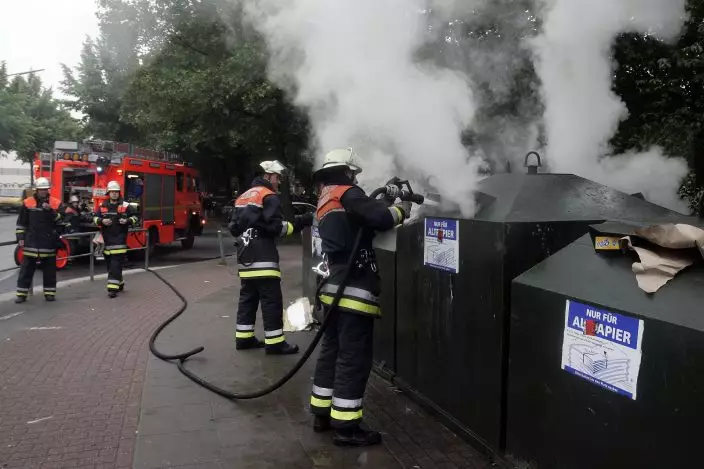For the 45th year in a row, seven of the most powerful people in the world will get together for an informal summit that has weathered everything from the Cold War through the global financial crisis to U.S. President Donald Trump's Twitter feed.
Despite ups and downs, the Group of Seven remains a key forum for tackling issues that cross borders: the economy, trade, financial crises, terrorism, money laundering, climate change and diseases like AIDS and tuberculosis.
Here are key things to know ahead of the summit Saturday through Monday in the resort town of Biarritz in France's southwestern Basque country.

FILE - In this July 16, 2006, file photo G8 leaders from left, Italy's Prime Minister Romano Prodi, German Chancellor Angela Merkel, U.S. President George W. Bush, British Prime Minister Tony Blair, French President Jacques Chirac, Russian President Vladimir Putin, Canadian Prime Minister Stephen Harper, Japan's Prime Minister Junichiro Koizumi, Finnish Prime Minister Matti Vanhanen and European Commission President Jose Manuel Barroso, walk off following a group photo in front of the Konstantinovsky Palace in St. Petersburg, Russia. The G-7 is an informal club of rich democracies that aim to enhance their friendship and synchronize their views. (AP PhotoAlexander Zemlianichenko, File)
INFORMAL, WELL-OFF, DEMOCRATIC AND POLITICAL
The G-7 is an informal club of rich democracies that aim to enhance their friendship and synchronize their views. Countries take turns chairing the annual summit, which typically ends with a final statement expressing financial and political commitments. It has no charter, rule book or bureaucracy of its own. The summit's decisions are only enforceable through peer pressure and leaders' desire to follow through on their promises, yet that can be significant. The G-7 Research Group at the University of Toronto says that countries complied with 76% of their commitments from last year's summit in Canada, despite its somewhat ignominious end in a Trump Twitter storm.
The members are: Canada, France, Germany, Italy, Japan, the United Kingdom and the United States.

FILE - In this July 9, 1993 file photo U.S. President Bill Clinton, right, shakes hands with Russian President Boris Yeltsin prior to the meeting of the Group of Seven summit at the Akasaka Palace in Tokyo. The G-7 is an informal club of rich democracies that aim to enhance their friendship and synchronize their views. Countries take turns chairing the annual summit, which typically ends with a final statement expressing financial and political commitments. (AP-PhotoItsuo Inouye, File)
FRIENDS IN A TURBULENT WORLD
The G-7 was originally a response by leaders of Western democracies to the economic shocks and recession of the mid-1970s. Those included the collapse of the post-World War II exchange rate system in which currencies were pegged to the dollar and an oil boycott by Arab countries that led to soaring energy prices and the worst economic downturn since the Great Depression. French President Valery Giscard d'Estaing hosted the first one at Rambouillet, outside Paris, in 1975.
The idea was to get past the bureaucracy and slow decision-making that hobbled larger international organizations to achieve a fast, coherent response to trouble.

FILE - In this May 27, 2017, file photo demonstrators back up after a short contact with police during an anti-G7 rally near the venue of the G-7 summit in the Sicilian town of Taormina, Italy. For the 45th year in a row, seven of the most powerful people in the world will get together for an informal summit that has weathered everything from the Cold War through the global financial crisis to U.S. President Donald Trump’s Twitter feed. (AP PhotoGregorio Borgia, File)
WHAT THEY DISCUSS
The agenda typically reflects the big issues of the moment: the host sets the agenda while leaders often meet one to one and can discuss anything else.
The global economy was the original focus for the G-7. But it has expanded to tackle security, terrorism, human rights and the environment. Initiatives have included supporting global trade negotiations, agreeing on economic stimulus and avoiding protectionism, figuring out debt relief for poor countries, and setting up a fund to fight HIV/AIDS, tuberculosis and malaria.

FILE - In this May 28, 2007, file photo fire fighters extinguish a burning waste container during clashes with protestors during a demonstration in Hamburg, Germany. Thousands of people demonstrated against the ASEM meeting and the upcoming G-8 summit in Heiligendamm at the Baltic Sea. The G-7 is an informal club of rich democracies that aim to enhance their friendship and synchronize their views. The initial group was six, with Canada added in 1976. Russia joined in 1998 but was suspended over its occupation of Ukraine's Crimean Peninsula in 2014. (AP PhotoPatrick Lux, File)
SHARED VALUES
As democracies, the G-7 have a unity of purpose and trust hard to duplicate in other forums such as the larger Group of 20 leaders' summit, which started in 2008 and includes states such as China and Russia presenting different models of politics and economic development that don't necessarily include free speech or an emphasis on human rights.
"The cooperation among the G-20 is much less routine," says Henning Riecke, head of the transatlantic relations program at the German Council on Foreign Relations. "The states are more different and there is more friction to be expected. I would not expect the same amount of unity and direction when it comes to influencing world affairs, when it comes to setting norms, when it comes to influencing conflicts."

FILE - In this July 7, 2005, file photo British Prime Minister Tony Blair, center, speaks during a group photo of G8 and other leaders at the G8 summit at the Gleneagles Hotel in Auchterarder, Scotland. Explosions on London's transport system killed dozens of people and caused chaos in the British capital at rush hour that morning. Standing left of Blair is U.S. President George W. Bush and right is French President Jacques Chirac. For the 45th year in a row, seven of the most powerful people in the world will get together Saturday through Monday for an informal but influential summit. (Charlie BibbyFinancial Times via AP, Pool)
John Kirton, director of the G-7 Research Group, says that "if you need a group of democratically committed powers, the G-7 is the only place in the global village to go."
ARGUMENTS CAN GET HEATED
Trump has shaken up the assumptions of close cooperation, particularly by rejecting the support by the other six for the Paris climate accord. He has also gone his own way by calling for Russia's readmission to the group and caused a stir after the 2018 summit in Charlevoix, Canada, when he tweeted criticism of host Justin Trudeau and repudiated the final joint statement.
Trump's approach makes the summit outcomes less predictable, and could narrow the scope for cooperation.
Yet the G-7 has seen conflict before and survived. U.S. President Ronald Reagan and French President Francois Mitterrand clashed in 1982 at Versailles, France, over trade with the Soviet Union and officials from both countries afterward dismissed key parts of the final statement.
While the differences between Trump and the others are real, Kirton said "that tweet (at the Canada summit) actually changed nothing in the real world of the G-7. It's not as if the American officials stopped working on G-7 stuff." Additionally, it is Trump's turn to host the summit next year, and he may wish to earn some goodwill to ensure a summit that burnishes his image ahead of the U.S. presidential election.
WHY IS IT SEVEN?
The initial group was six, with Canada added in 1976. Russia joined in 1998 but was suspended over its occupation of Ukraine's Crimean Peninsula in 2014. The seven members have reached out to outsiders in several ways. One way is including top officials from the European Union as an eighth participant, giving the other EU member countries a voice. This year, France invited India, Chile, South Africa and Australia as important regional democracies, plus four African nations: Burkina Faso, Egypt, Senegal, and Rwanda.
IF AT FIRST YOU DON'T SUCCEED, JUST KEEP TRYING
A two-day summit is too short to find definitive solutions to complex issues. The G-7 puts its collective clout behind projects carried forward by national governments or in other international forums such as the International Monetary Fund or the Organization for Economic Cooperation and Development.
An example would be debt relief for poor countries.
Partial relief was agreed at the 1988 Toronto summit, but the leaders wrestled with the issue until the 2005 summit in Gleneagles, Scotland, where they finally settled the matter — after a total of eight summits.


